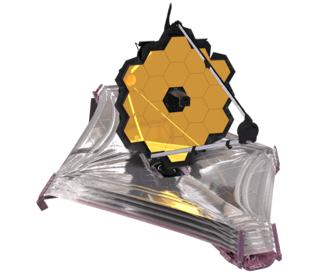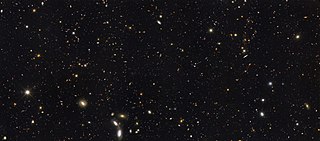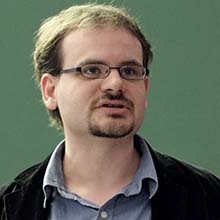
A galaxy is a system of stars, stellar remnants, interstellar gas, dust, and dark matter bound together by gravity. The word is derived from the Greek galaxias (γαλαξίας), literally 'milky', a reference to the Milky Way galaxy that contains the Solar System. Galaxies, averaging an estimated 100 million stars, range in size from dwarfs with less than a thousand stars, to the largest galaxies known – supergiants with one hundred trillion stars, each orbiting its galaxy's center of mass. Most of the mass in a typical galaxy is in the form of dark matter, with only a few percent of that mass visible in the form of stars and nebulae. Supermassive black holes are a common feature at the centres of galaxies.

The Hubble Space Telescope is a space telescope that was launched into low Earth orbit in 1990 and remains in operation. It was not the first space telescope, but it is one of the largest and most versatile, renowned as a vital research tool and as a public relations boon for astronomy. The Hubble telescope is named after astronomer Edwin Hubble and is one of NASA's Great Observatories. The Space Telescope Science Institute (STScI) selects Hubble's targets and processes the resulting data, while the Goddard Space Flight Center (GSFC) controls the spacecraft.

The Space Telescope Science Institute (STScI) is the science operations center for the Hubble Space Telescope (HST), science operations and mission operations center for the James Webb Space Telescope (JWST), and science operations center for the Nancy Grace Roman Space Telescope. STScI was established in 1981 as a community-based science center that is operated for NASA by the Association of Universities for Research in Astronomy (AURA). STScI's offices are located on the Johns Hopkins University Homewood Campus and in the Rotunda building in Baltimore, Maryland.

The Hubble Deep Field (HDF) is an image of a small region in the constellation Ursa Major, constructed from a series of observations by the Hubble Space Telescope. It covers an area about 2.6 arcminutes on a side, about one 24-millionth of the whole sky, which is equivalent in angular size to a tennis ball at a distance of 100 metres. The image was assembled from 342 separate exposures taken with the Space Telescope's Wide Field and Planetary Camera 2 over ten consecutive days between December 18 and 28, 1995.

The James Webb Space Telescope (JWST) is a space telescope designed to conduct infrared astronomy. Its high-resolution and high-sensitivity instruments allow it to view objects too old, distant, or faint for the Hubble Space Telescope. This enables investigations across many fields of astronomy and cosmology, such as observation of the first stars and the formation of the first galaxies, and detailed atmospheric characterization of potentially habitable exoplanets.
Observational cosmology is the study of the structure, the evolution and the origin of the universe through observation, using instruments such as telescopes and cosmic ray detectors.

NASA's series of Great Observatories satellites are four large, powerful space-based astronomical telescopes launched between 1990 and 2003. They were built with different technology to examine specific wavelength/energy regions of the electromagnetic spectrum: gamma rays, X-rays, visible and ultraviolet light, and infrared light.
Luminous infrared galaxies or LIRGs are galaxies with luminosities, the measurement of brightness, above 1011 L☉. They are also referred to as submillimeter galaxies (SMGs) through their normal method of detection. LIRGs are more abundant than starburst galaxies, Seyfert galaxies and quasi-stellar objects at comparable luminosity. Infrared galaxies emit more energy in the infrared than at all other wavelengths combined. A LIRG's luminosity is 100 billion times that of the Sun.

APM 08279+5255 is a very distant, broad absorption line quasar located in the constellation Lynx. It is magnified and split into multiple images by the gravitational lensing effect of a foreground galaxy through which its light passes. It appears to be a giant elliptical galaxy with a supermassive black hole and associated accretion disk. It possesses large regions of hot dust and molecular gas, as well as regions with starburst activity.

Rogier Arnold Windhorst is an astronomer and a professor of physics and astronomy at Arizona State University. He received his Ph.D. in astronomy in 1984 from the University of Leiden and did post doctorate work at Mt.Wilson and Las Campanas Observatories. He currently serves as associate chair at Arizona State and is among six Arizona state faculty who were awarded Regents Professor appointments in 2006; he presides over the School of Earth and Space Exploration at the university. In 2008, he became Foundation Professor of Astrophysics at Arizona State University and co-director of the ASU Cosmology Initiative.

Neocatastrophism is the hypothesis that life-exterminating events such as gamma-ray bursts have acted as a galactic regulation mechanism in the Milky Way upon the emergence of complex life in its habitable zone. It is one of several proposed solutions to the Fermi paradox since it provides a mechanism which would have delayed the advent of intelligent beings in local galaxies near Earth.

The Great Observatories Origins Deep Survey, or GOODS, is an astronomical survey combining deep observations from three of NASA's Great Observatories: the Hubble Space Telescope, the Spitzer Space Telescope, and the Chandra X-ray Observatory, along with data from other space-based telescopes, such as XMM Newton, and some of the world's most powerful ground-based telescopes.

The Astronomy and Astrophysics Decadal Survey is a review of astronomy and astrophysics literature produced approximately every ten years by the National Research Council of the National Academy of Sciences in the United States. The report surveys the current state of the field, identifies research priorities, and makes recommendations for the coming decade. The decadal survey represents the recommendations of the research community to governmental agencies on how to prioritize scientific funding within astronomy and astrophysics. The editing committee is informed by topical panels and subcommittees, dedicated conferences, and direct community input in the form of white papers summarizing the state of the art in each subdiscipline. The most recent report, Astro2020, was released in 2021.

MACS0647-JD is a galaxy with a redshift of about z = 10.7, equivalent to a light travel distance of 13.26 billion light-years. If the distance estimate is correct, it formed about 427 million years after the Big Bang.

Radio Galaxy Zoo (RGZ) is an internet crowdsourced citizen science project that seeks to locate supermassive black holes in distant galaxies. It is hosted by the web portal Zooniverse. The scientific team want to identify black hole/jet pairs and associate them with the host galaxies. Using a large number of classifications provided by citizen scientists they hope to build a more complete picture of black holes at various stages and their origin. It was initiated in 2010 by Ray Norris in collaboration with the Zooniverse team, and was driven by the need to cross-identify the millions of extragalactic radio sources that will be discovered by the forthcoming Evolutionary Map of the Universe survey. RGZ is now led by scientists Julie Banfield and Ivy Wong. RGZ started operations on 17 December 2013.
The Mikulski Archive for Space Telescopes (MAST) is an astronomical data archive. The archive brings together data from the visible, ultraviolet, and near-infrared wavelength regimes. The NASA funded project is located at the Space Telescope Science Institute (STScI) in Baltimore, Maryland and is one of the largest astronomical databases in the world.

Marcia Jean Rieke is an American astronomer. She is a Regents' Professor of Astronomy and associate department head at the University of Arizona. Rieke is the Principal Investigator on the near-infrared camera (NIRCam) for the James Webb Space Telescope (JWST). She has also served as the deputy-Principal Investigator on the Near Infrared Camera and Multi-Object Spectrometer (NICMOS) for the Hubble Space Telescope (HST), and as the co-investigator for the multiband imaging photometer on the Spitzer Space Telescope, where she also acted as an outreach coordinator and a member of the Science Working Group. Rieke was also involved with several infrared ground-based observatories, including the MMT Observatory in Arizona. She was vice chair for Program Prioritization of the Astro2010 Decadal Survey Committee, "New Worlds, New Horizons". Marcia Rieke is considered by many to be one of the "founding mothers" of infrared astronomy, along with Judith Pipher.

SMACS J0723.3–7327, commonly referred to as SMACS 0723, is a galaxy cluster about 4 billion light years from Earth, within the southern constellation of Volans. It is a patch of sky visible from the Southern Hemisphere on Earth and often observed by the Hubble Space Telescope and other telescopes in search of the deep past. It was the target of the first full-color image to be unveiled by the James Webb Space Telescope (JWST), imaged using NIRCam, with spectra included, showing objects lensed by the cluster with redshifts implying they are 13.1 billion years old. The cluster has been previously observed by the Hubble Space Telescope (HST) as part of the Southern MAssive Cluster Survey (SMACS), as well as Planck and Chandra.















